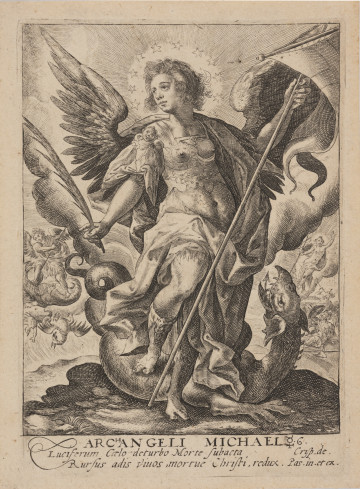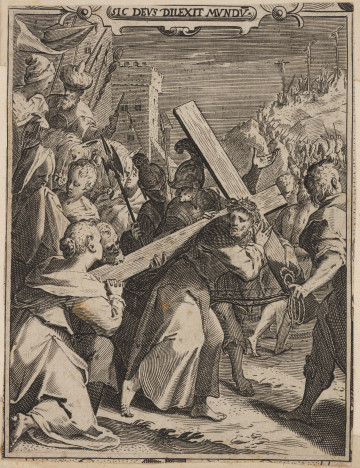
Entombment
1600 — 1700
National Museum in Szczecin
Part of the collection: Renaissance and Baroque painting
Composed in an oval on a convex sheet, the epitaph commemorates a deceased man, shown in the foreground, from the perspective of the waist up. Dressed in bourgeois costume typical of Dutch fashion in the 2nd half of the 17th century, he holds a red rose in his hand. His portrait is a picture within a picture, for it has been integrated into the background, which is the representation of the biblical theme of the Resurrection. Above the open tomb in the central part is the figure of Christ in a luminous halo. Below, the Roman soldiers guarding the tomb are shown waking up in fright, while in the background on the left is a landscape depicting Jerusalem and Golgotha with three crosses. The three women from under the hill heading towards Christ's tomb are the three Marys spoken of in the bible: Mary Magdalene, Mary of Clopas and Mary Salome, who went to anoint the body of Christ on the morning of the Resurrection (Mk 16:1-6). The source of inspiration for this work was a copperplate illustration of the Bible by Matthäus Merian, a Swiss artist active in Germany, from 1627. The composition was repeated, retaining the layout of the open tomb and the positioning of the soldiers. The arrangement of Christ's robes was the painter's own invention. The author has also changed the position of the hand in which the Saviour holds the banner. In the schematic example of the work, Christ raises his hand in a gesture of blessing. The work should be counted among the examples of guild workshop painting from Protestant Pomerania, where its prototype was popular in the 17th century. In the context of Protestant theology, the Resurrection symbolised victory over death, the devil and sin. The rose held by the deceased also had a rich symbolic meaning in sepulchral art, alluding to the Passion or the passing of time. The oval form of the painting indicates that it probably had a carved casing, not preserved to our times. Justyna Bądkowska
Author / creator
Object type
painting
Technique
oil technique
Material
copper plate, wood
Origin / acquisition method
acquisition
Creation time / dating
Creation / finding place
Owner
Muzeum Narodowe w Szczecinie
Identification number
Location / status

1600 — 1700
National Museum in Szczecin

1590 — 1600
National Museum in Szczecin

1590
National Museum in Szczecin
DISCOVER this TOPIC
National Museum in Lublin
DISCOVER this PATH
Educational path